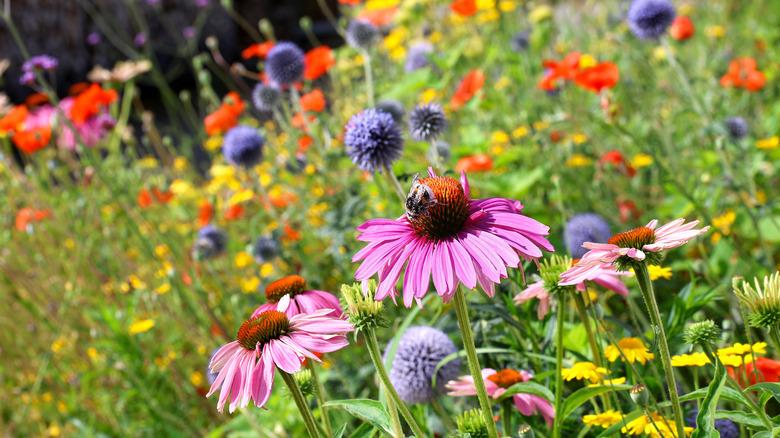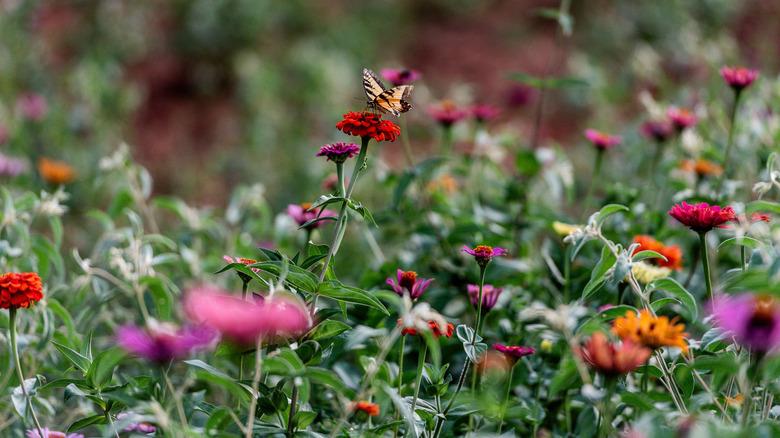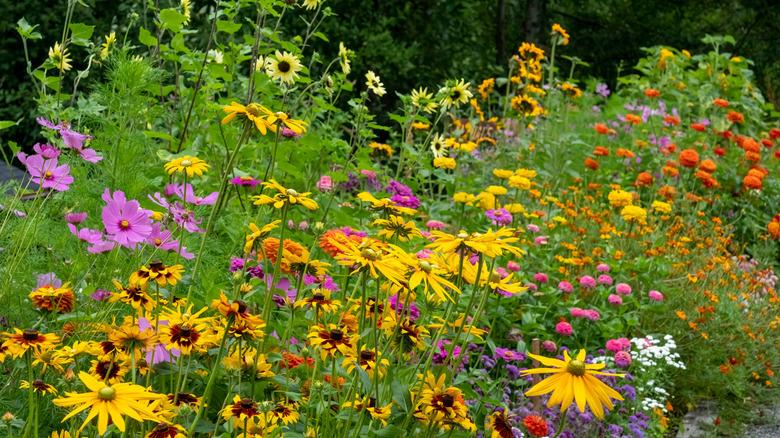The Best Flowers To Plant In June To Keep Your Summer Garden Dazzling
June is the time for getting out in the garden and planting your summer show. Most of the spring bulbs have faded or disappeared, and in all but the coldest parts of the United States, the last frost is a distant memory. It's time to freshen your garden's look with these summer bloomers. Rarely does a plant flower from early spring to late fall, but you can compensate for that by planting a mix of annuals and perennials so that you don't have to replant everything each year. The basic difference between annuals and perennials is that annuals will give you longer summer blooms but last only a year, while perennials will bloom in summer for multiple years, though generally for a shorter period than annuals.
These gorgeous flowers will flourish best in full sun in rich, well-draining soil that is evenly moist. All are widely available for sale, so if you're planting in June and want your flowers to bloom this year, purchase flowering plants at garden centers rather than growing them from seed. Annual flowers, like marigolds, garden verbena, and zinnias, can be purchased from garden centers can be planted outside at any time after the last frost date, but you'll want to plant any perennials (such as tickseed, coneflowers, and black-eyed Susans) quickly so that they have time to establish themselves before blooming.
Pollinator-friendly annuals
By June, annual flowers purchased from garden centers often are no longer seedlings but are short flowers already in bloom. They usually come in small pots or packs of six "plugs." Plant them on a cloudy day so that they're not sun-stressed. Dig a hole the depth of the plant's container. Never pull the plant out by the stem. Moisten it first, then use a trowel to gently slip it from the container. Loosen the roots if they're all wrapped around the plant, then place it into the hole. After planting, give it a good soak of water.
Marigolds (Tagetes spp.) are native to Central America and Mexico and can grow in U.S. hardiness zones 2 to 11. As they grow, deadhead the spent flowers so that they bloom continuously. They are deer and rabbit resistant, attract bees and butterflies, and are even edible. Garden verbena (Verbena x hybrida) produces clusters of small, bright, low-growing flowers in a wide variety of colors in zones 8 through 11. It looks great in hanging pots, over the tops of garden walls, or trailing through rock gardens and borders. Deadheading the flowers will keep them blossoming all summer.
Zinnias (Zinnia elegans) will grow in any full-sun site in zones 2 to 11. With a wide range of species and cultivars, they can grow from button-sized blooms of 8 inches to 4-foot-tall giants. Zinnias are susceptible to powdery mildew and other diseases, but there are ways to care for zinnias. Alternatively, you can plant a more disease-resistant variety like the 'Profusion' cultivars, which are a cross between Zinnia elegans and Zinnia angustifolia.
Sun-loving perennials
Perennials at garden centers usually come in larger pots than annuals, so you'll need to find more space for them in your garden. On a cloudy day in June, dig a hole a little deeper and wider than the pot and add compost. Water both the hole and your plant while it's still in its pot. Hold the plant by its base, tip the pot upside down, and gently slip the plant out. Loosen any root-bound roots before planting. Backfill the hole with soil and water thoroughly.
Hardy in U.S. hardiness zones 3 through 8, coneflowers (Echinacea purpurea) are tall and photogenic, and a complement to any prairie meadow or wildflower garden. They attract bees and butterflies to their purple or white blooms through much of the summer, after which their cone-shaped seedheads attract goldfinches and other birds. Coneflowers also make excellent cut flowers. On the other hand, tickseed (Coreopsis grandiflora) is drought-tolerant and does well in the summer heat in zones 4 to 9. This easy-to-grow, pollinator-friendly perennial will flower in early to midsummer and potentially re-bloom later in the year if you deadhead or prune coreopsis. It easily self-sows, so allow some of the flowers to go to seed.
Black-eyed Susans (Rudbeckia hirta) are easy-to-grow plants whose blooms can last from mid-summer into fall. They will spread their seeds widely in zones 3 to 8. If you want to prevent them from popping up all over your garden, deadhead the flowers before they start producing seeds. Their long stems make for great cut flower arrangements. Bees will feast on them and birds will appreciate the seeds.


